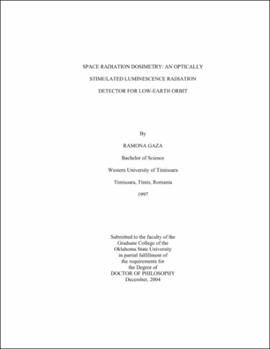| dc.contributor.advisor | McKeever, S. W. S. | |
| dc.contributor.author | Gaza, Ramona | |
| dc.date.accessioned | 2013-11-26T08:26:32Z | |
| dc.date.available | 2013-11-26T08:26:32Z | |
| dc.date.issued | 2004-12 | |
| dc.identifier.uri | https://hdl.handle.net/11244/6891 | |
| dc.description.abstract | Scope and Method of Study: The purpose of this study was to investigate Al2O3:C as a potential optically stimulated luminescence (OSL) radiation detector for Low-Earth Orbit. The OSL response of Al2O3:C was characterized in terms of its luminescence efficiency for a variety of heavy charged particles (HCPs) with features similar to those found in space. The HCP irradiations were performed using the HIMAC accelerator at Chiba (Japan), the proton facility at Loma Linda (CA) and the NSRL facility at Brookhaven (NY). The OSL curves were further investigated to obtain information about the 'mean efficiency' and 'mean LET', parameters that needed to assess the absorbed dose and the dose equivalent. This analysis was applied for simulated mixed radiation fields (ICCHIBAN) and actual space radiation exposures (i.e., STS-105, BRADOS, and TRACER). In parallel, the thermoluminescence response of dosimetry materials LiF:Mg,Ti and CaF2:Tm was also studied. | |
| dc.description.abstract | Findings and Conclusions: The OSL efficiency of Al2O3:C exposed to HCPs was found to decrease with increasing linear energy transfer (LET) for the investigated LET range (i.e., from keV/um to 459 keV/um). For simulated mixed radiation fields with a strong low-LET component, the results indicated that the OSL calibration methods (i.e., T - method and R - method) can be used with good accuracy to obtain information about the absorbed dose and the dose equivalent. Nevertheless, for mixed fields with a strong high-LET component these methods will give larger errors when estimating the absorbed dose and the dose equivalent. For actual space radiation exposures, the results indicated that different materials/calibration methods (i.e., the LiF:Mg,Ti/HTR method and the CaF2:Tm/ peak peak method) give different results in terms of 'mean efficiency' and 'mean LET'. This was explained by suggesting that none of the above calibration methods can give information about the true average LET of the incident radiation, but rather about the 'mean LET' weighted by the dosimeter efficiency. | |
| dc.format | application/pdf | |
| dc.language | en_US | |
| dc.rights | Copyright is held by the author who has granted the Oklahoma State University Library the non-exclusive right to share this material in its institutional repository. Contact Digital Library Services at lib-dls@okstate.edu or 405-744-9161 for the permission policy on the use, reproduction or distribution of this material. | |
| dc.title | Space radiation dosimetry: An optically stimulated luminescence radiation detector for low-earth orbit | |
| dc.contributor.committeeMember | Anderson, Bruce J. | |
| dc.contributor.committeeMember | Arena, Andrew S. | |
| dc.contributor.committeeMember | Rosenberger, Albert Thomas | |
| dc.contributor.committeeMember | Westhaus, Paul A. | |
| osu.filename | Gaza_okstate_0664D_1169.pdf | |
| osu.accesstype | Open Access | |
| dc.type.genre | Dissertation | |
| dc.type.material | Text | |
| dc.subject.keywords | space radiation dosimetry | |
| dc.subject.keywords | optically stimulated luminescence | |
| dc.subject.keywords | radiation detector | |
| dc.subject.keywords | low-earth orbit | |
| thesis.degree.discipline | Physics | |
| thesis.degree.grantor | Oklahoma State University | |
